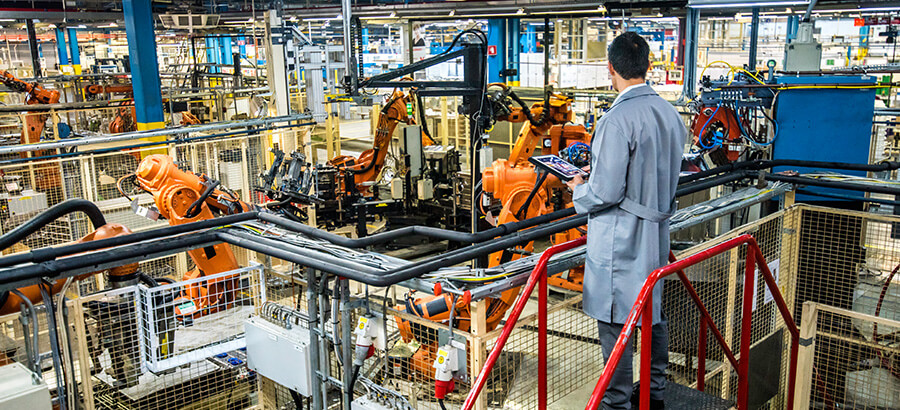The UK Industrial Machinery and Equipment (IM&E) industry makes a significant contribution to the economy, but there’s a growing realization that the post Coronavirus/COVID-19 world will not be the same as it was. My guess is that organizations will start to look at digital strategies a lot more seriously after the pandemic. Companies that don’t understand that things will need to change may not survive.
In recent years, the establishment of intelligent automation has had a great impact on the productivity of manufacturing industries. A report on the UK’s mechanical-equipment industry concluded that some key growth opportunities will come from automation in manufacturing and the adoption of ‘4IR’ (fourth industrial revolution) strategies. The experience of many industries during the country’s lockdown shows how important it is to be able to run operations no matter where your staff are, and for uninterrupted communications with customers and suppliers. The IM&E industry will need to start making a plan to digitalize the business.
Where can industrial machinery and equipment businesses focus to ensure they will succeed in the world of manufacturing post-2020?
They can start by looking at the Smart Manufacturing concept. Smart manufacturing involves making information about manufacturing processes available when and where it is needed, in the form it is needed, to empower smart decisions about business operations.
I will go into more detail about Smart Manufacturing in a forthcoming blog; a key to enabling it is to use digital technologies.
For this blog I want to discuss how IM&E businesses can tackle their common challenges using available technology that is fairly easy to implement.
Design and engineering:
You need to have a system and process to maintain control of product design. The management of change orders can be a significant issue, so you need to be able to coordinate engineering changes with both internal departments, such as production, as well as with third parties. A collaborative platform should enable customers to be involved in the design process, and give suppliers access so they can see what they need to change. In addition, support for mobile access can speed up the acceptance and implementation of engineering change requests.
Quoting:
To provide better service to customers and quick turnaround times, your quotations system should provide you with an accurate view of costs for material, labor and outside services to enable you to create timeous quotes. The ability to share updated information easily within the organizations and with other external parties will allow you to update prices quicker and provide suppliers with up-to-date details if requirements change.
Planning and scheduling:
Post-COVID-19, IM&E businesses will need to have flexible and agile planning and scheduling capability. It will require using near real-time demand and supply data to create realistic production, purchasing and supply transfer schedules. You will also need to have a 360° view of your production so you can monitor labor and machine efficiency, identify capacity constraints and quickly and accurately schedule jobs to maximize order fulfillment and resource utilization whilst maintaining profitability.
Managing inventory:
The pandemic has brought to the fore the importance of managing inventory even in the midst of chaos. To help maintain the right inventory levels, manufacturers should be using real-time tracking throughout the whole supply chain and production process. Using serial and lot tracking, it’s possible to see the location and quantity of goods; and by cooperating with suppliers you can see where sub-contracted items are in the chain before they even arrive at your factory.
Syncing supply with demand:
Syncing production and supply with customer demand is a key requirement to prevent over-production and line stoppages. This involves having not only efficient order processing and supply chain management functions but also accurate production planning to optimize output and reduce costs.
Manage product and part traceability:
To meet compliance requirements, the ability to trace materials and parts from their origin through manufacturing to final destination is becoming a critical component of many businesses. Having the means to track lots and serial numbers provides visibility through the supply, production and delivery chain, which allows you to trace and analyze the source of defects should they occur.
Support the Industrial Internet of Things:
The Industrial Internet of Things (IIoT) refers to interconnected sensors, instruments and other devices in the factory, networked together via a secure environment. Collecting and aggregating this information provides data for analysis to deliver improved productivity in areas such as overall equipment effectiveness, real-time information on equipment and job status, job costing accuracy, as well as better operational visibility for decision-making.
Reviewing your processes:
How many businesses have realized that their back-office processes are not geared towards remote working? Now with the benefit of experience, you can see what processes need to be reviewed. After the pandemic is over, you should see what you need to change in your existing ERP system to accommodate remote operations.
In his book Black Swans, Nassim Taleb, refers to fragility and antifragility.
“Some things benefit from shocks … Yet, in spite of the ubiquity of the phenomenon, there is no word for the exact opposite of fragile. Let us call it antifragile. Antifragility is beyond resilience or robustness. The resilient resists shocks and stays the same; the antifragile gets better.”
In order to do business in the post-COVID-19 world, businesses should be looking how they can change processes, technology and operations to become antifragile. If they haven’t realized already, companies need to re-evaluate the way they operate. Some things will go back to the way they were before the pandemic, others will change forever.







